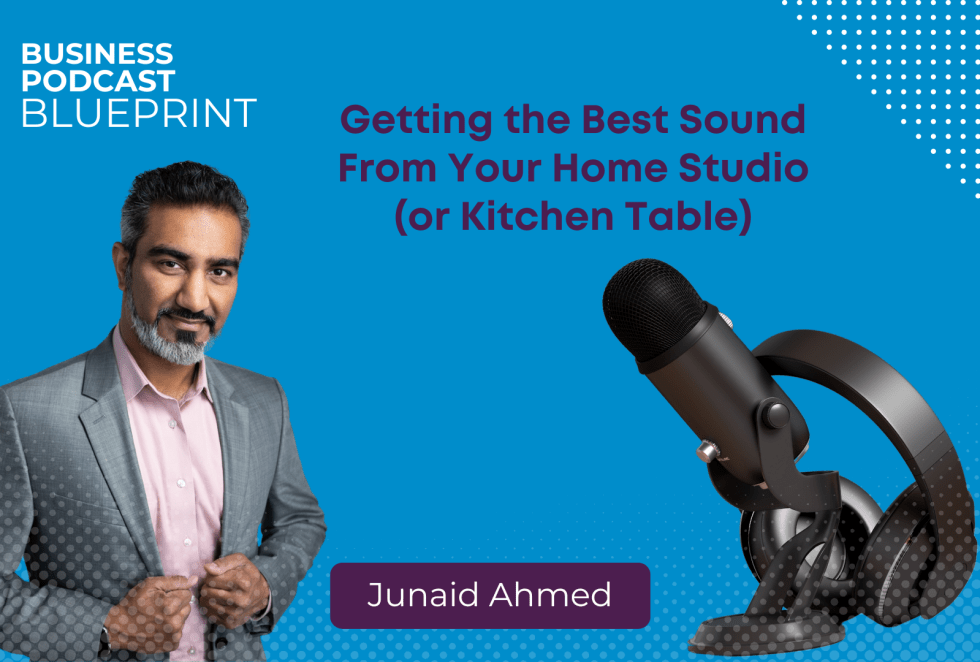Are you struggling with optimizing your audio setup for your podcast? If so, you’re not alone. On this episode of the Business Podcast Blueprint Show, I talk to Junaid Ahmed, an expert in home audio and video setup. Junaid shares his tips on how to optimize your recording space, troubleshoot audio issues, and pick the right microphone for your needs.
Junaid Ahmed is an expert in podcasting, voice acting, and audio engineering, with over 15 years of experience in the industry. He has a strong background in photography and video cameras, dating back to 1989, and stumbled upon podcasting in 2012. In 2018, he began documenting his beekeeping journey and interviewing guests on his podcast. With over 400 interviews under his belt, Junaid is an authority in audio and video setup for home studios. He has worked with a diverse range of clients, from small businesses to Fortune 500 companies, to create high-quality audio content that engages their audience. Junaid is passionate about technology and how it can enhance storytelling, keeping himself up-to-date with the latest developments in the field. He shares his expertise on several podcasts and blogs, and he hosts his own podcast, Hacks & Hobbies, where he interviews experts in different fields and shares insights on how to turn hobbies into successful businesses.
- To optimize and troubleshoot your own podcast setup, you need to get all the variables right, which includes analyzing the space you’re recording in, picking the right microphone, and using the right equipment to capture high-quality audio and video.
- The ideal home studio removes all friction to creating content and is designed for permanent installation, but in reality, many people don’t have a dedicated space for recording and have to make do with what they have.
- To optimize a closed office or multi-use space for podcast recording, you need to analyze the space and add personality to it, pick the right microphone for the space, and use acoustic treatments like rugs, paintings, and curtains to absorb sound and reduce echo.
- To optimize a temporary space like a hotel room, use a lapel mic to capture high-quality audio and pay attention to lighting. “What you want to do in those kind of spaces, especially if you’re doing video, is to have a lapel mic on you,” Junaid says. “It’s close to you and it only has a very small distance of capturing your video and your audio.” You can also use a small closet or portable sound treatments to absorb sound and reduce noise.
- Lapel mics or headsets with microphones are recommended for capturing good audio in conference rooms with flat walls and wide empty spaces.
- Recording platforms like Riverside, Zencastr, and StreamYard can save recordings in high quality wav files, whereas Zoom compresses recordings into mp3 files.
- It’s possible to start podcasting with a few hundred dollars, and mid $2,000 can get you a good set of gear, including a microphone, camera, headphones, and lighting equipment.
- It’s better to start with minimal investment and upgrade as you go.
- Troubleshooting audio involves testing volume levels, microphone placement, compression, and drivers.
- Testing different platforms, environments, and optimization techniques can further improve sound quality.
- When you look into the camera lens instead of at the person you’re speaking to, the end result is more natural for the end viewer.
- Junaid remarks, “One of the things that my friend talks about is he’ll put a picture of me or another friend of his and put it right next to the lens. Now you’re having a conversation with your friend…”
- Practice talking to the camera lens to improve the delivery of your message.
- Nvidia has come out with an AI recording platform that automatically changes where your eyes are looking.
- Adobe has a software called Character Animator that tracks your face and eye movements and maps it to a puppet, which was used to animate a live episode of The Simpsons and engage with the audience.
- We have been able to connect with each other and grow as human beings thanks to the technological advancements in video manipulation.
KEY QUOTES:
“The idea behind setting up a home studio is to remove any and all friction to creating content.” – Junaid Ahmed
“You’ve got to know the type of microphone you’re using, where the driver is capturing the audio and you’re talking into that space as opposed to the offside. That can help improve the audio by miles.” – Junaid Ahmed
“All of this has enabled us to not only connect with each other but also grow as a person and grow as a human being.” – Junaid Ahmed
Resources:
One Stone Creative | LinkedIn | Twitter | Facebook | Instagram | Website
Junaid Ahmed | Home Studio Mastery | LinkedIn | Twitter | Hacks & Hobbies podcast
Adobe Character Animator | Apple | Skype | Zoom | Zencastr | Blue Yeti | Nvidia | Riverside | StreamYard

